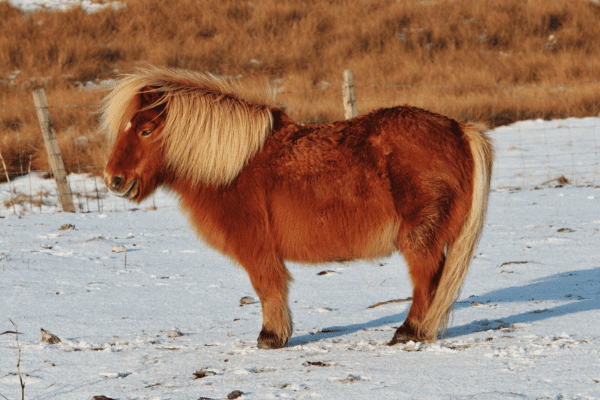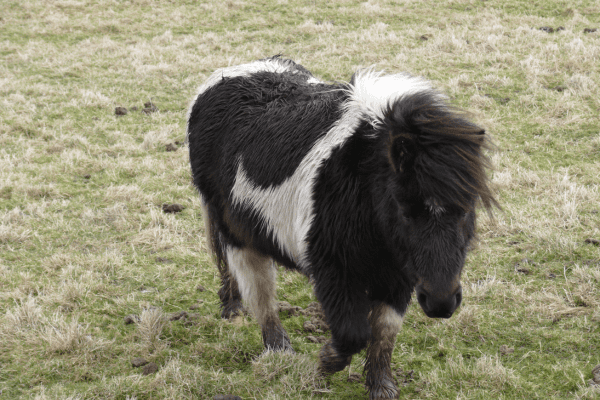The Shetland Pony, an esteemed equine breed from Scotland’s Shetland Isles, presents a unique blend of miniature grace and rugged durability. Standing at a maximum height of 107 cm (42 inches) at the withers, these ponies are renowned for their compact yet sturdy physique. They are characterized by a luxuriant coat, tailored by nature for the unforgiving climate of their homeland, and their notably short legs.
Despite their small frame, Shetland Ponies are incredibly strong for their size, a quality that has historically made them reliable for riding, driving, and as pack animals. This breed not only symbolizes the resilient spirit of the Scottish isles but also serves as a versatile and reliable companion in various equine pursuits.
History:
The Shetland Pony, famed for its resilience and endurance, boasts an astounding history dating back to the Shetland Islands off Scotland’s northeastern coast over millennia – its tale one of survival and adaptability.
Origins in the Shetland Islands
Shetland Ponies can be traced back to the Bronze Age; these islands, famed for their rugged terrain and extreme weather, became home to these ponies during this era.
Initial native Shetlands equines were small yet sturdy, well-suited to survive under its scarce resources and severe conditions.
Influence of Norse and Celtic Ponies
Historical accounts suggest a dramatic transformation in the breed due to crossbreeding with ponies brought over from Norway by Norse settlers during their occupation of the islands.
Between 2000 and 1000 BCE, Celtic ponies brought by early settlers interbred with local breeds to add new characteristics and strengths.
Adaptation to Harsh Environments
Shetland ponies evolved over millenia due to the harsh environment and limited food resources of Shetland Isles, becoming extremely hardy creatures capable of withstanding conditions that would strain many other breeds.
Roles Throughout History
For much of their early history, Shetland ponies served as versatile workhorses – they pulled carts, carried essential items like peat and coal, as well as ploughing agricultural land.
The Industrial Revolution marked a monumental change to Shetland pony use. A sudden surge in coal demand led to thousands of Shetland ponies being transported across Britain in order to meet it.
Shetland ponies were widely employed as pit ponies in coal mines in both eastern United States and Germany, often working until their last breath. Additionally, Shetland ponies served a similar function.
Preservation and Breeding Initiatives
To meet these demanding roles and protect the breed, the Shetland Pony Stud-Book Society was founded in 1890 to preserve its purity while encouraging high-quality breeding animals. Its purpose is to uphold this standard while upholding purity.
Furthering these efforts, in 1957 the Shetland Islands Premium Stallion Scheme was instituted; offering subsidies to breed high-quality registered stallions to strengthen breed characteristics.
Global Influence and Legacy
Shetland Ponies have long been revered for their adaptability and resilience, inspiring the development of several other pony breeds such as the American Shetland Pony, Pony of the Americas in the US, and Deutsches Classic Pony in Germany – each having roots back to Shetland Isles.
These offshoot breeds carry on the robust qualities of the Shetland Pony and bear witness to its longstanding legacy and central place in equine history.
Shetland Ponies have long been revered as adaptable and strong animals, with centuries of shared history between human beings and these magnificent equines, shaping both culture and working environments alike. Their story stands as an important testament to human-equine connections forged over many years of mutual reliance.


Characteristics:
The Shetland Pony, known for its strength and resilience, developed as a result of living in challenging conditions on its native Shetland Islands. As such, its physical attributes and qualities were refined accordingly over time, giving birth to its unique combination.
Distinctive Physical Traits
A pony’s head is distinctively small, with wide-set eyes that convey a keen and alert expression.
Their ears are small but keen, always alert for changes in their environment.
Notable characteristics of this breed include their short, muscular necks that support compact bodies that showcase its strength and endurance.
Body Structure
Shetland Ponies are known for their short yet powerful legs – an identifiable trait which contributes to their remarkable strength. Furthermore, the Shetland’s cannon bones are smaller relative to its overall size – creating an anatomical feature unique among ponies.
An instantly recognisable sign of strength and robustness is a short back paired with a deep girth; these characteristics signify a sturdy frame.
Shetland Ponies are known for their distinct springy stride, adding charm and agility.
Coat and Mane
One of the most distinctive aspects of Shetland Ponies is their long, thick mane and tail, which not only adds aesthetic value but also serves a practical function in providing protection from the elements.
Due to the harsh climate on Shetland Islands, dogs bred specifically for these islands have developed dense double coats designed to provide extra insulation against cold and wet temperatures during winter.
Color Variations
The Shetland Pony can exhibit almost any horse coat color, presenting a wide range of hues and patterns. However, it is noted that spotted coat patterns are not typical of the breed.
Longevity
Shetland Ponies have become legendary for living beyond 30 years, attesting to their remarkable longevity and robust health.
the Shetland Pony is not simply defined by its small size; rather it represents an impressive blend of strength, resilience and adaptability. All aspects of its physicality – from its muscular neck to dense coat – have been molded by its need to survive and thrive in the harsh landscape of Shetland Islands.
As a result of these traits combined together the Shetland Pony has earned itself a place as an esteemed breed within equine communities around the globe.
The Contemporary Journey of Shetland Ponies: From Traditional to Modern Roles
The Shetland Pony, with its proud heritage from the Shetland Isles, has successfully transitioned into numerous roles in today’s modern world, showcasing its versatility and endearing qualities across multiple domains.
Favored among Young Riders
Shetland Ponies have become increasingly popular with young riders. Due to their small stature and gentle temperament, these ponies make excellent starting horses for children learning the ropes.
At horse shows, these ponies can often be seen participating in harness driving classes and ridden events; sometimes being driven by young riders for competition as well as leisure purposes. All these ponies play both recreational and educational roles for riders of all ages and experience levels.
Recreational and Educational Roles
Shetland Ponies have long been valued members of riding schools and stables, serving as reliable mounts for novice riders and serving as safe mounts for kids who are starting out horseback riding. Thanks to their gentle dispositions, Shetlands make excellent opportunities to introduce children to the pleasures of horseback riding.
Ponies add family-friendly experiences such as fairs and amusement settings by providing pony rides that create unforgettable memories for young visitors.
Therapeutic and Supportive Capacities
The gentle temperament of this breed makes them ideal for therapeutic riding programs, offering physical and emotional support to people facing various difficulties.
Equine experts play a vital role in petting zoos as well, where they interact with visitors to foster appreciation of horses.
Racing and Performance
In an exhilarating setting, the Shetland Pony Grand National in the UK features miniature versions of this famous race with young jockeys showing off these ponies’ surprising agility and speed.
Additionally, several ponies still perform their traditional roles on the Shetland Islands – specifically transporting peat – demonstrating their longstanding use in rural tasks.
Youth Engagement in Harness Racing
Junior Harness Racing in Queensland, Australia is an innovative program dedicated to engaging children between ages 6-16 in harness racing. Here they learn the nuances of racing while driving Shetland Ponies under supervision – developing future generations of equestrian enthusiasts.
Guidance and Assistance Responsibilities
Notably, miniature Shetlands have been trained as guide animals similar to guide dogs, highlighting their adaptability and intelligence. Other miniature horse breeds have also taken on this task which showcases their potential in providing assistance and service capacities.
The Shetland Pony has come a long way since its origins as an island breed, becoming a valuable addition in various modern settings from sporting events, educational settings, or therapeutic services.
Remaining charming and versatile members of the equine family, they continue to charm audiences around them and play an integral part in making people’s lives brighter.


Today Status:
Today, Shetland ponies are celebrated not just for their historical importance; they are beloved companions among children and novice riders, often due to their patient and gentle disposition.
Though small in stature, these powerful ponies can carry both children and small adults easily – making them ideal for educational or therapeutic riding programs.
Shetland ponies’ intelligent and friendly personalities make them ideal candidates for various equine sports and activities, from driving and harness racing to jumping and dressage – from driving and harness racing, all the way through jumping and dressage competition, Shetland ponies have proven that they can compete gracefully and agilely against larger breeds in terms of versatility.

